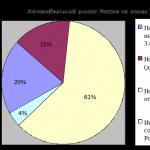The goal of every gardener is to harvest a good and healthy harvest of vegetables every year. However, unfortunately, this is not always possible to achieve - garden plants can be affected and, which, in turn, harm the yield, spoil the presentation and quality of the fruit.
In this article we will talk about one of the healthy and tasty vegetables -. We will tell you what actions need to be taken in order to minimize the risks of contracting zucchini diseases, the main signs of diseases and methods of treating them.
You can use solutions, wipe the leaves with a soap solution (100 g / 10 l of water). Gentle folk methods are also used: treatment with infusions (1:10 water, leave for a day, dilute 1:3) and (1 kg of dried leaves / 10 hot water, leave for two days).  It also helps to plant plants in close proximity to zucchini that repel aphids, etc.
It also helps to plant plants in close proximity to zucchini that repel aphids, etc.
Signs. is a small white flying insect that feeds on plant sap. Its favorite habitats are greenhouses and dense vegetable gardens. When infected by this pest, honeydew or honeydew forms on the upper part of the leaf, and the whiteflies themselves and their larvae like to sit under the lower part. This insect is dangerous primarily because sooty fungus or other pathogens can subsequently settle in the places it infects.  Control measures. To destroy this scourge, other insects are introduced into greenhouses - for example, encarsia or the macrolophus bug. Natural enemies of whiteflies in open areas are ladybugs.
Control measures. To destroy this scourge, other insects are introduced into greenhouses - for example, encarsia or the macrolophus bug. Natural enemies of whiteflies in open areas are ladybugs.
 When attacked by ticks, the entire plant is covered with cobwebs. It begins to lag behind in growth, loses productivity and its level of resistance to low temperatures decreases. The pest spreads especially strongly in hot and dry seasons.
When attacked by ticks, the entire plant is covered with cobwebs. It begins to lag behind in growth, loses productivity and its level of resistance to low temperatures decreases. The pest spreads especially strongly in hot and dry seasons. Control measures. By following the rules of agricultural technology, you can reduce the risk of ticks settling in your garden. When they appear, treatment with a decoction of leaves, infusions of onion peels, and potato tops is recommended.
Chemical treatment can be done both for prevention during bud break (Acartan, Karbofos, Metaphos, Phosfamide, etc.) and for treatment.
Sprout fly
Signs. The sprout fly is a pest that damages the seedlings of zucchini and many other plants. This is a small (3-5 mm) gray insect. In order to lay larvae, it appears in the spring. After laying eggs, the larvae appear in 2-10 days, and after two weeks they begin pupation. They overwinter in the soil. Seriously harm germinating seeds and seedlings. – they should scare away slugs.
Was this article helpful?
Thank you for your opinion!
Write in the comments what questions you have not received an answer to, we will definitely respond!
You can recommend this article to your friends!
You can recommend this article to your friends!
48
once already
helped
Zucchini aphids are mainly inhabited by melon aphids. The larvae overwinter in weeds. The breeding season begins in spring, when the air temperature exceeds +12°C. At first, aphids feed on weeds, and over time, they move to vegetable plants. Warm, humid weather promotes the development of aphids on zucchini. Both greenhouse crops and open ground plantings are under threat. A pest attack can be recognized by the following signs:
The surface of the leaf becomes contaminated with insect secretions, disrupting the life of the plants.- twisted sheet plate;
- underdeveloped, drying buds;
- whitish “pieces” and sticky liquid on the surface of the leaf - discarded old shell and honeydew secreted by aphids;
- accumulations of larvae on the inside of the leaf, black, brown or green;
- sudden invasion of ants in a greenhouse.
Basic methods of killing aphids
If appropriate measures are not taken in time, plants stop growing. Aphids infect zucchini with pathogenic viruses, which leads to damage and death of the plant. Existing methods of combating melon aphids are shown schematically in the table:
| Methods | The essence of the method | Events | |||||||||||||||||||||||||||||||
| Mechanical | Mechanical extermination of insects | Manual collection of larvae; removing and burning affected leaves and flowers; use of glue traps; rinsing with water |
|||||||||||||||||||||||||||||||
| Biological | Attracting biological enemies of aphids - insects and birds | Planting bait plants for hoverflies, earwigs, and lacewings; Placement of birdhouses, bird feeders and drinkers in the garden |
|||||||||||||||||||||||||||||||
| Agrotechnical | Increasing plant immunity and resistance to pests | Fertilizing with complex fertilizers; timely watering and weeding |
|||||||||||||||||||||||||||||||
| Chemical | Prevention and destruction of pests | Spraying plants with herbal remedies and insecticides; preventive treatment of greenhouses; You can start with the simplest thing.
Features of the fight against greenhouse aphids When a sulfur bomb is burned, sulfur dioxide is released, which has a detrimental effect on pests. When a sulfur bomb is burned, sulfur dioxide is released, which has a detrimental effect on pests. It is necessary to prepare a greenhouse or frame-film shelter for the next season in the fall, immediately after the last harvest.
It is impossible to defeat aphids that have settled in a greenhouse without destroying greenhouse ants. To combat them, special crayons, sticky tapes and insecticidal agents Pochin, Muraviin, Medvetoks, Anteater are used. A set of agrotechnical and preventive measures allows you to completely get rid of greenhouse aphids. The effectiveness of modern insecticidesTo get rid of aphid infestations, special insecticides are used.
 In cloudy weather, the effectiveness of insecticides, as a rule, decreases, so treatment is carried out on a dry, warm and windless day. Even the most effective drugs should be alternated so that pests do not become addicted.
Traditional methods of killing aphidsIf the use of toxic insecticides is undesirable, they resort to traditional methods. They are also effective, but their use is only advisable in small areas and indoors. It is problematic to prepare the amount of drug required for a large area. In addition, infusions made according to folk recipes require repeated use once a week. Moreover, for repeated treatments, it is better to alternate the products, which is not economically justified on an industrial scale. The most popular pest control solution among gardeners is a soap solution. It is used both as a stand-alone drug and as an additive to herbal infusions to adhere to the leaves. The most common recipes:
Complex fertilizers/feedings to combat aphidsPlants with elastic, strong and dense leaves have a higher chance of resisting aphid infestation. Therefore, as a preventive measure, abundant watering and regular fertilizing with phosphorus-potassium fertilizers are recommended. An overview of complex fertilizers that increase the resistance of zucchini to aphids is given in the table below:
|
Zucchini aphids are mainly inhabited by melon aphids. The larvae overwinter in weeds. The breeding season begins in spring, when the air temperature exceeds +12°C. At first, aphids feed on weeds, and over time, they move to vegetable plants. Warm, humid weather promotes the development of aphids on zucchini. Both greenhouse crops and open ground plantings are under threat. A pest attack can be recognized by the following signs:
- twisted sheet plate;
- underdeveloped, drying buds;
- whitish “pieces” and sticky liquid on the surface of the leaf - discarded old shell and honeydew secreted by aphids;
- accumulations of larvae on the inside of the leaf, black, brown or green;
- sudden invasion of ants in a greenhouse.
The surface of the leaf becomes contaminated with insect secretions, disrupting the life of the plants.
Basic methods of killing aphids
If appropriate measures are not taken in time, plants stop growing. Aphids infect zucchini with pathogenic viruses, which leads to damage and death of the plant. Existing methods of combating melon aphids are shown schematically in the table:
| Methods | The essence of the method | Events |
| Mechanical | Mechanical extermination of insects | Manual collection of larvae; removing and burning affected leaves and flowers; use of glue traps; rinsing with water |
| Biological | Attracting biological enemies of aphids - insects and birds | Planting bait plants for hoverflies, earwigs, and lacewings; Placement of birdhouses, bird feeders and drinkers in the garden |
| Agrotechnical | Increasing plant immunity and resistance to pests | Fertilizing with complex fertilizers; timely watering and weeding |
| Chemical | Spraying plants with herbal remedies and insecticides; preventive treatment of greenhouses; extermination of soil ants |
|
| Folk | Prevention and destruction of pests | Treatment with herbal infusions, ash, soap and soda solutions |
You can start with the simplest thing.
The basis for protecting greenhouse zucchini from aphids is prevention. When growing zucchini indoors, it is important to comply with fertilizer application rates, maintain optimal humidity (up to 80%) and temperature (not higher than 25°C). Weeds must be destroyed thoroughly. " It is necessary to prepare a greenhouse or frame-film shelter for the next season in the fall, immediately after the last harvest.
- Collect and destroy plant debris (weeds, old tops, garbage).
- Remove the top layer of soil to a depth of 5 cm. Once every 5 years, it is recommended to completely replace all the soil.
- Wash the glass and walls with a solution of copper sulfate. Whitewash the supports and wooden parts of the frame with lime.
- Set fire to the sulfur bomb.
- Repeat treatment with lime and copper sulfate in April before the start of the season.
It is impossible to defeat aphids that have settled in a greenhouse without destroying greenhouse ants. To combat them, special crayons, sticky tapes and insecticidal agents Pochin, Muraviin, Medvetoks, Anteater are used. A set of agrotechnical and preventive measures allows you to completely get rid of greenhouse aphids.

When a sulfur bomb is burned, sulfur dioxide is released, which has a detrimental effect on pests.
The effectiveness of modern insecticides
To get rid of aphid infestations, special insecticides are used.
| A drug | How to use | Advantages | Flaws | Efficiency mark |
| Bitoxibacillin | Repeated (with an interval of 10–15 days) spraying in dry weather with an aqueous solution (80–100 g per 10 liters of water) | Harmless to humans, bees, birds, animals, used in any phase of the growing season, does not accumulate in fruits | The finished solution cannot be stored | Highly effective microbiological preparation |
| Akarin | Spot treatment of lesions in dry, windless weather (6 ml per 1 liter of water) |
A single spray is sufficient; processing is allowed during the harvest period | Harmful to bees | Ineffective at ambient temperatures below +18°C |
| Fitoverm | Double spraying (6 ml per 1 liter of water) | Environmentally safe, does not accumulate in fruits | Cannot be mixed with other drugs | Highly effective 4th generation biological product |
| Tanrek | Single spraying (5 ml per bucket of water) | Economical (consumption no more than 5 liters per 100 m²) | Toxic to bees, birds and earthworms | Highly effective, long period of protective action |
In cloudy weather, the effectiveness of insecticides, as a rule, decreases, so treatment is carried out on a dry, warm and windless day. Even the most effective drugs should be alternated so that pests do not become addicted.
Tip #1.When spraying with insecticides, choose a spray bottle with small holes, such as an old perfume spray bottle.
In case of severe aphid infestation of small greenhouses and greenhouses, the following treatment method is effective: a film is placed on top of the plants on the arches, with an insecticide applied to the inside, and the edges are sprinkled with earth. As a result, the pest completely dies within a day. "

Traditional methods of killing aphids
If the use of toxic insecticides is undesirable, they resort to traditional methods. They are also effective, but their use is only advisable in small areas and indoors. It is problematic to prepare the amount of drug required for a large area. In addition, infusions made according to folk recipes require repeated use once a week.
Moreover, for repeated treatments, it is better to alternate the products, which is not economically justified on an industrial scale. The most popular pest control solution among gardeners is a soap solution. It is used both as a stand-alone drug and as an additive to herbal infusions to adhere to the leaves. The most common recipes:
- ash decoction: 300 g boil for 15 minutes in 10 liters of water;
- onion peel infusion: 1 cup of raw material is poured into 3 liters of boiling water, left for 3 hours, diluted in 10 liters of water;
- infusion based on tomato (possibly potato) tops: brew 500 g of greens in 10 liters of boiling water, leave for a day;
- mustard solution: 100 g of powder per 5 liters of water;
- dandelion infusion: take 300 g of greens and roots per bucket of water, soak for 3 hours;
Tip #2. Some gardeners spray aphid clusters with vodka using a spray bottle. Vodka has a detrimental effect on aphids, but alcohol can leave burns on the leaves.
Complex fertilizers/feedings to combat aphids
Plants with elastic, strong and dense leaves have a higher chance of resisting aphid infestation. Therefore, as a preventive measure, abundant watering and regular fertilizing with phosphorus-potassium fertilizers are recommended. An overview of complex fertilizers that increase the resistance of zucchini to aphids is given in the table below:
| Fertilizer | Operating principle | Method of application | Dosage | Advantages |
| Agricola-5 | Increases resistance to pests and diseases, adverse weather conditions | Root and foliar (spraying) fertilizing up to 5 times per season | 25 g per 10 liters of water for irrigation up to 25 m² bed area | Does not contain chlorine and heavy metals, environmentally friendly |
| Hello Turbo | Reduces the negative impact of stress factors, promotes active absorption of nutrients | Root feeding (with watering) once every 2 weeks | 15 g per 10 liters of water per 1.5 m² | Without chlorine, contains an optimal set of macro and microelements |
| Blank sheet | Stimulates growth, increases resistance to pests, diseases, weather conditions | Root and foliar feeding, dry application before watering is allowed | 10 g per 8 liters of water | Compatible with all organic fertilizers |
| Multiflor | Increases immunity, stimulates growth, strengthens the root system of plants | Root and foliar feeding | 10 g per 10 liters of water | Reduced consumption rate and 100% absorption of nutrients |

Zdraven stimulates the development of zucchini, increasing resistance to aphids and other pests.
Mistakes gardeners make when ridding zucchini of aphids
- You should not overfeed plants with nitrogen fertilizers, since aphids are primarily attracted to juicy young greens.
- It is unacceptable to leave “green” paths in the greenhouse. In greenhouses, aphids first settle on weeds, then attacking cultivated plants. All grass in a greenhouse or greenhouse must be carefully weeded out.
- You cannot buy seedlings of unknown origin on the market. Often such planting material is already infected with aphids.
- It is wrong to believe that homemade preparations are safe for humans and animals. Sometimes folk recipes use poisonous raw materials, for example, tobacco, dope, henbane, and celandine. When working with them, as with chemicals, you need to wear personal protective equipment. In addition, violation of the dosage can lead to leaf burns. Vegetables after processing should not be eaten for at least 10 days.
- You should not place squash beds near bird cherry, viburnum and linden. These trees are a favorite wintering place for aphids.
Gardeners' questions about aphid control
Question No. 1. As you know, ladybugs are predators that eat aphids. How to attract these insects to a squash patch?
Firstly, it is necessary to limit the use of chemical means of protection. Secondly, plant buckwheat, dill, tansy, and legumes near the zucchini. The ladybug loves dandelion and yarrow. You can purchase ladybug larvae in specialized stores to populate the greenhouse with them.
Question No. 2. What is the difference between systemic and contact insecticides?
Contact insecticides, such as Inta-vir, Kinmiks, FAS, kill pests when applied directly. The drug acts only at the site of spraying, without protecting other parts of the plant. Use only in dry weather, since effectiveness depends on precipitation.
If aphids hide in places inaccessible for spraying, it is advisable to use systemic insecticides Aktara, Biotlin, Tanrek. The damaging substance penetrates the vessels of the leaf. The pest dies when it eats any part of the plant. Weather does not affect the effectiveness of the drug.
Question No. 3. Are there two-in-one products that combine disinfection with fertilizing?
In addition to the active substance for combating melon aphids, the newest drug Iskra contains potassium fertilizers. This is a very economical product. Take 1 tablet per bucket of water. This solution is enough to spray 100 m² of plantings. Before processing, ripe fruits must be collected.
Question No. 4. Why does the effectiveness of insecticides decrease with repeated treatments?
Aphids, like other pests, get used to the chemicals used against them, so the products need to be alternated, using each no more than 2-3 times in a row.
Many gardeners are faced with the problem of squash diseases in open ground and how to combat them; a photo will help identify the problem.
Zucchini suffers from viral or fungal pathologies and is affected by various pests. An accurate understanding of the problem will help you decide on the choice of method, how to deal with it, how to preserve and protect the crop.
How to deal with zucchini diseases?
The most common zucchini diseases, depending on the pathogen that causes them, are fungal. The culprits of the diseases can cause the death of leaves, fruits or roots. Control methods common to all diseases: compliance with crop rotation, timely removal of debris and weeds from the site, destruction of affected parts of the plant.
Favorable conditions for the development of diseases are nighttime temperature changes and increased humidity, for example, after rain or during excessive watering. The source of the pathogen is affected plants and seeds. Insects facilitate the spread.

Anthracnose
Fungal diseases of zucchini and their treatment are the most common problem that arises when growing crops in open ground.
Zucchini anthracnose is a fungal disease caused by a fungus of the genus Colletotrichum. First of all, weak and mechanically damaged plants at any stage of development are affected. Anthracnose affects zucchini planted in soil with high acidity, with insufficient amounts of potassium and phosphorus fertilizers.
Spots of yellow or brown color with a dark brown or purple edging appear on the leaves, which quickly grow first over the entire surface of the leaf plate, and then onto the stem, flowers and fruits. The lesions deepen into the thickness of the plant organs and impede the movement of water and nutrients.

The stems and fruits become covered with weeping, slimy spots and begin to rot over time, and the leaves begin to curl. The fruits shrink and acquire a bitter taste. Damage to the root zone leads to the death of the plant.
At the initial stage of anthracnose development, the shoots are sprayed with a 35% solution of colloidal sulfur, a 1% solution of Bordeaux mixture (100 g of copper sulfate and quicklime are diluted in 10 liters of water), and EM preparations.
Before sowing, the soil is dug up with wood ash, dolomite flour or lime to reduce acidity, and fertilizers containing phosphorus and potassium are applied.

Bacteriosis
Bacteriosis comes in two types and manifests itself either as angular leaf spot or as blossom-end rot of fruits.
With angular spotting, the leaves first turn white; why and why zucchini leaves turned white is not easy to determine, since similar damage develops with several other diseases of the crop. If later, instead of small white spots, angular brown spots appear, this is bacteriosis.
The disease affects the plant at the stage of cotyledon emergence. At first, the spots become dark green, then brown, dry out, and collapse, forming holes between the veins of the leaf plate. Because the holes are bounded by veins, they have an angular shape. Brown, watery sores appear on the fruits, which lead to deformation of the zucchini.

The fight consists of removing the affected parts of the crop. For minor lesions, the shoots are treated with 1% Bordeaux mixture, 0.4% copper oxychloride solution. As a preventive measure, the seed is treated with a 0.02% solution of zinc sulfate, in which the seeds are immersed for a day and then dried.
Another type of disease is apical bacteriosis of fruits. In this case, the tops of the fruit first turn yellow, then brown spots appear on them. The lower part can grow further. Subsequently, the fruits become glassy and rot.
It is impossible to save a plant from apical bacteriosis - it will have to be destroyed.

White rot sclerotinia
The fungus can cause various putrefactive diseases of zucchini in open ground; it is much easier to identify the type of rot with a photo.
With white rot, or sclerotinia, a flaky white coating with black dots first appears on the leaves of squash, which over time spreads to the fruits, tendrils, cuttings and stems. White colonies of the fungus develop on them - sclerotia, which soon turn black.

Sclerotia fall off and overwinter in the ground, and in the spring they are a source of infection. Damaged areas of the plant become covered with mucus, soften and rot. If the base of the stem rots, the plant dies.
Excess nitrogen in the soil contributes to plant infection. Treatment consists of treating the affected areas on the zucchini with crushed activated carbon, wood ash or quicklime.
To combat the pathogen, the following measures are taken:

- Use for irrigation with warm water.
- Root feeding with a mixture of 10 liters of water, 1 g of zinc sulfate, 2 g of copper sulfate, 10 g of urea.
- In dry and hot weather, the affected plant organs are removed. The sections are sprinkled with crushed coal or washed with a 0.5% solution of copper sulfate.
- Substances containing calcium are used as fertilizer: ground chicken egg shells, wood ash at the rate of 200 g of substance per 1 m². Phosphate fertilizers are introduced.
- The soil is irrigated with a solution of Fitolavin, and compost is added to restore the microflora.

Gray mold botrytis
Another type of putrefactive mycosis is gray rot. At the same time, the greenness of the grass changes, leaves become sick, and fruit ovaries suffer. Most often, young vegetable ovaries are affected. The fruits become watery, like other affected tissues, become wet, soften, turn brown, and become covered with a gray coating with black dots. The pathogen spores persist in the soil for up to 2 years.
The reasons that aggravate the conditions and methods of contracting the disease are the same as for white rot. The methods of fighting are also the same. The affected areas of the fruit can be powdered with a mixture of copper sulfate and chalk, combined in a 1:2 ratio.

Root rot
Root rot affects the plant, like blossom end rot, in the fruit formation phase and is manifested by rotting of the root system and neck. The affected tissue darkens and turns brown, becomes rotten and soft. The lower foliage turns yellow. The culture stops growing and fades, and eventually dies.
Root rot occurs due to frequent application of organic fertilizers. Plants can be treated with biological products Trichodermin and Glycoladine, which contain fungal spores that are antagonists of the rot pathogen.
Seeds 3 weeks before sowing can be treated with TMTD (Tiram) at the rate of 5-6 g/kg of seed. Infected plants are watered with a 0.1% Previkur solution at the rate of 200-300 ml for each bush. In addition, solutions containing metalaxyl and mefenoxam are used.

Powdery mildew
Another fungal disease of zucchini is white powdery mildew. In this case, ailments are manifested by the appearance on the leaves, less often on the stem and cuttings, of small round white spots sprinkled with powdery pollen - fungal spores.
Over time, the spots increase in size, merge with each other and cover the entire plant, as a result of which it turns yellow and dries out due to the impossibility of photosynthesis. In addition, the body of the fungus sucks nutritious juices from the crop, which leads to the impossibility of fruit formation. The fungus overwinters on weeds.
Affected plants are sprayed with a solution of colloidal sulfur 35%, a solution of sodium phosphate 0.5%, a solution of isophrene 10% or powdered with ground sulfur at the rate of 300 g per 100 m².

Downy mildew peronosporosis
Downy mildew affects zucchini leaves at all stages of the growing season. Initially, yellow spots appear on the upper side of the leaves, which on the other side of the leaf are covered with gray-violet spores of the fungus.
The spots enlarge and merge with each other, which leads to browning and drying of the foliage. The disease progresses very quickly. Sometimes the outer side of the leaf becomes covered with a white coating. Despite the similar description, methods for treating peronosporosis are somewhat different from removing powdery mildew.
During treatment, watering is completely stopped. Healthy leaves are treated with a tank mixture, a solution of copper oxychloride, the drug Metriam, a mixture of fungicidal drugs and growth stimulants. For prevention, seeds are poured with hot water (+50 °C) for 15 minutes.

Black mold of pumpkin
Black squash mold can appear on the leaves and other above-ground organs of squash. Outwardly, it appears as small light brown spots, which merge over time and turn into foci of necrosis, covered with a black coating - spores of a fungus from the genus Aspergillus.
As a result of its vital activity, the green parts of the plant turn yellow and dry out, and the fruits stop developing, wrinkle and rot. High humidity and large temperature changes stimulate the course of the disease.
If a plant gets sick and is not cured, all the zucchini on the site gets sick.

Fusarium wilt
Diseases and pests: Zucchini pests most often affect the above-ground parts of plants. Fusarium is no exception. The first sign of this disease is yellowing and weakening of the upper leaves of the bush.
The stems turn brown at the bottom (root part) and become covered with a pink or orange coating. Fusarium also affects the roots. As a result, within a few days the plant dries out and dies. On a cross section of the stems, you can see browning of the veins.
In the initial stage of damage, you can dust the bush and the ground around it with wood ash, but this is of little use. The struggle consists of improving the soil - sowing green manure plants, applying organic and mineral fertilizers, using crop rotation, removing weeds, applying EM products and calcium preparations.

How to deal with zucchini pests?
The appearance and number of pests is affected by air humidity and temperature, crop density, irrigation intensity and general care of the site and crops. The reasons for the appearance of insects are too dense planting, littered beds, and high humidity.

melon aphid
The melon aphid first attacks weeds and then moves on to cultivated plants. Aphids gnaw leaf blades on the underside, stems, ovaries, and flower petals. The affected organs curl, dry out, and the flowers fall off. The growth and development of plants slows down, and then they die. During a season, aphids can produce up to 20 generations. The pest overwinters on plant debris.
Prevention methods include timely weeding of seedlings, removal of plant residues immediately after harvesting, and proper crop rotation.
To destroy aphids, use 10% solutions of Karbofos or Trichlorometaphos-3, an infusion of tobacco dust (1 part of the dust is infused with 10 parts of water and diluted with clean water in a ratio of 1:3), an infusion of yarrow (1 kg of grass is infused in 10 liters of water for 2 days).

Whitefly
The whitefly is a small white insect covered with powdery pollen. Both adults and larvae eat leaves and young shoots, suck out the juice from them, and also infect them with various diseases. The feces of adult insects corrode the leaf blade, which leads to the appearance of black spots on it.
Damage to zucchini is manifested by discoloration, curling and death of the leaves, and subsequently the entire plant.

The most effective drugs against whiteflies: Aktara, Actellik, Double Effect, Commander, Tanrek, Oberon and others. The products are diluted according to the instructions and sprayed on the plants and the soil around them with the frequency recommended by the manufacturers. Watering zucchini with insecticide solutions is more effective.
You can spray zucchini with onion or garlic infusion daily for a week.

Spider mite
The activities of spider mites are very harmful. It affects the undersides of leaf blades and entwines them with a thin web. Yellow dots form in the affected areas, then the leaves turn yellow completely, acquire a marble pattern and dry out. If the damage is severe, the zucchini will die. Ticks produce up to 15 generations during the season, and overwinter in groups under plant debris and debris.
There are ways to get rid of the pest; spider mites can be destroyed by the following means:

- Spraying leaves in hot weather. Water can be replaced with infusion of onion peels or garlic. To prepare tinctures, 200 g of raw materials are poured into 10 liters of water and left for 2 days.
- Spraying with a 20% chloroethanol solution.
- Irrigation with Isofen solution 10%.
- Spraying ground sulfur at the rate of 300 g per 100 m².
To improve the adhesive properties of solutions, add 30 g of laundry soap.

Sprout fly
Sprout fly larvae can be found on germinating seeds and seedlings. Gray flies have a body size of no more than 3-5 mm. The insect summer begins in the spring. They lay eggs in places with high humidity, especially near manure.
Within a week, larvae hatch from the eggs and destroy the crops within 14 days. The larvae then pupate. During the warm season, 2-3 generations of germ flies appear. Germ fly larvae can be found especially often on leaves in cold summers.
As a preventive measure, you need to carefully incorporate manure into the soil, remove plant debris, and regulate watering. In the spring, before the beginning of summer, Karbofos or Fufanon are added to the soil. The aboveground part of the plant can be pollinated with wood ash, ground black pepper, and tobacco dust. For irrigation, use the following solution: 200 g of table salt and 10 liters of water.

Slugs
Slugs gnaw out the embryos in the seeds and eat the leaves on the shoots. Having fixed itself on a section of the stem, the mollusk gnaws it, which leads to the death of most of the plant. Later, pests gnaw out the ovary of the fruit or damage young zucchini, eating the pulp in them and even making tunnels.
In addition to reducing the yield, snails leave traces of mucus and other secretions on the affected area of the stem, leaf or fruit, thereby reducing the marketability of the product. Once in storage with the collected fruits, the slugs continue to cause damage, destroying the crop.

The easiest way to combat mollusks is mechanical. They are collected manually or using special traps. Traps are made from pieces of burlap or plywood and placed around the perimeter of the area. Protective grooves up to 30 cm wide are dug around the plantings and filled with pine needles, sand, and sawdust, which impede the progress of pests.
Special preparations are used: Metaldehyde granules are laid out (at the rate of 4 g per 1 m²), the consumption of which leads to the death of slugs, the soil and plants are sprayed with a solution of copper or iron sulfate, and lime is sprayed.

Like other vegetables, they are susceptible to pests and diseases. It is better to start fighting various unpleasant diseases or harmful insects immediately, when the first signs appear.
Pests of zucchini include spider mites, melon aphids, and sprout flies. The main diseases affecting zucchini are powdery mildew, anthracnose, white rot, etc.
General measures to combat these pests and diseases come down to the following: alternation of crops, collection and destruction of plant residues and affected fruits, deep fall plowing or digging up the area after harvesting, and in greenhouses and greenhouses - replacement or disinfection of soil by thermal means, strict adherence to mode (avoid sudden temperature fluctuations), warming the seeds before planting in hot water (50 ° C) for 20 minutes followed by cooling in cold water, spraying 2-3 times with 1% Bordeaux mixture or 0.3% - copper oxychloride (30 g per 10 liters of water).


















